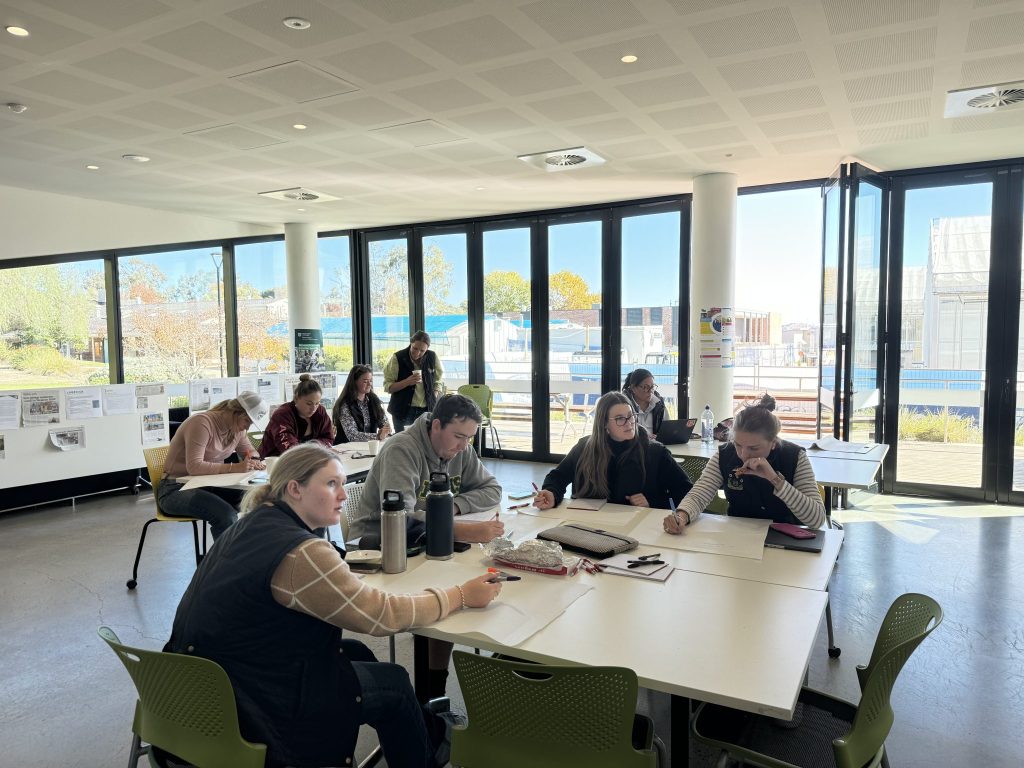Supporting On-Farm Labour During the Dry Times



In mid-2023 it became apparent that like many regions Holbrook and its local producers have been facing the challenge of attracting and retaining young, skilled workers on-farm.
To tackle this issue Holbrook Landcare Network, with the support of the Southern NSW Drought Resilience Adoption and Innovation Hub have been able to initiate the Supporting On-Farm Labour During the Dry Times Project. This project is characterised by it’s a co-design process seeking the collaboration of farmers, farm staff and industry experts to identify the root causes of employment and retention challenges, and explore potential solutions. This process aimed to facilitate knowledge exchange between farm business owners, peers and professionals to aid in addressing identified challenges.
Co-Designing Job Security and Development in Farming Communities During Drought
There were a number of moving part to this project in order to understand what the challenges local producers face when looking to recruit about into their businesses.
We conducted a series of co-design workshops centered on the key question…
“What solutions can be developed to attract, retain and upskill on-farm staff in the Holbrook region and increase job security during the dry times?
Farm Labour ThinkTank Co-Design Session with local Farmers
This session bought together local producers to lend their experience in managing farm labour and share their innovative ideas to collaboratively design solutions to support on-farm labour attraction, retention and development in the region. We look forward to inviting a diverse range of local producers into these conversations.
We asked our famers what issues and barriers they experienced on farm that reduce their capacity to attract and retain on-farm staff. The top 5 identified factors were;
- Housing and accommodation
- Skills and experience
- Isolation and social factors
- Uncertainty navigating and staying competitive with wages and employment terms
- Overcoming time constraints to conduct training and mentorship with staff.

What does your future on Australian farms look Like? - Workforce Co-Design Workshop and Survey

These co-design activities aimed to address the same question as the Producer ThinkTank, but with an audience made up of current and future workforce participants.
We conduced a intensive workshop with seven Charles Sturt University students, and on-farm perceptions survey with up to 48 responses!
We asked our workshop participants what they saw as the biggest barriers that they are currently facing in their careers in agriculture and on-farm. Here are the challenges they shared with us…
- Lack of access to land or capital
- Educational barriers or need for further training
- Uncertainty of potential roles in agriculture
- Limited or no connections in the industry
- Feeling isolated or unsupported as a young person in the community
- Limited job opportunities.
- Work/Life balance: Balancing work with additional study and expectations of weekend work.
- Availability of seasonal work/connection to be get involved.
- Accommodation and living arrangements.
- Employer willingness to teach and share knowledge, patience while teaching.
- Workplace culture, the motivation and energy of other members if the workplace contributing to a positive environment.
From the On-Farm Perception Survey we gained some key insights into how on-farm roles are perceived by potential candidates.
We learnt that 52% of respondents see working on-farm as an employee as a viable, long term career, with this percentage increasing to 78.9% if they were a manager, and 80% if they were business owners.
We also asked respondents what, if improved, would make on-farm roles more attractive and help retain them in on-farm roles. We identified three key areas of work including;
- Accommodation & On-Farm Infrastructure: increasing the accessibility and quality of onfarm accommodation and improving infrastructure such as yards, shearing sheds, and other areas of work including machinery.
- Social and Cultural: This includes improving work/life balance by managing how expectations are set and communicated.
- Workplace Culture including how workplace values are shared and demonstrated, how occupational health and safety is managed and supported
on-farm, and how employees received feedback and recognition for work. Social
connectivity, ensuring adequate opportunities for social connectedness in local communities and that employees are encouraged and supported to access these opportunities. - Training, Mentorship, Progression in roles and Increasing Awareness of Pathways: increased access to training, flexibility, and financial assistance from employers to undergo training. Capacity in the farm business for a supervisor/manager/owner mentorship.
Supporting On-Farm Labour During the Dry Times - A Literature Review
As part of the Supporting On-Farm Labour During the Dry Times Project we were able to engage with Professor Ruther Nettle and Andre Vickas from the University of Melbourne’s Rural Innovation Research Group.
Through this opportunity Prof. Nettle and Vickas worked to produce a comprehensive rapid literature assessment to highlight the current key insights and gaps in academic and industry literature surround attraction, retention and skills development in on-farm roles during drought.
This is a value reference material which supports the key findings from our co-design sessions conducted with local producers, workforce and industry professionals.
If you are interested in reading this literature review read it here.
Full On-Farm Labour Final Report
At the conclusion of this Project Holbrook Landcare Network worked to compile the insights on issues and barriers faced by farm businesses and workforce personnel, as well as explore ideas and areas of work that could be explored to overcome these challenges.
Our key findings and recommendations for us as an organisation and to our industry peers are presented in the On-Farm Labour Final Report.



